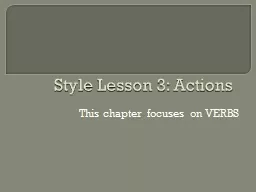

This chapter focuses on VERBS Sentences are stories Williams suggests that writers think of sentences as stories with characters subjects and actions verbs Important definitions Simple subject ID: 570730
Download Presentation The PPT/PDF document "Style Lesson 3: Actions" is the property of its rightful owner. Permission is granted to download and print the materials on this web site for personal, non-commercial use only, and to display it on your personal computer provided you do not modify the materials and that you retain all copyright notices contained in the materials. By downloading content from our website, you accept the terms of this agreement.
Slide1
Style Lesson 3: Actions
This chapter focuses on VERBS Slide2
Sentences are stories
Williams suggests that writers think of sentences as stories with characters (subjects) and actions (verbs).Slide3
Important definitions
Simple subject
Whole subject
Character
Action
Verb
The evidence that you offer is not reliable.Slide4
Subject verb
= character action
Back in elementary school, we learned that the subject of the sentence was the doer of an action and the verb of a sentence was the action.
Jane jumps. = subject verb (
doer/character
action) Slide5
Nouns
But the doer
(character) isn’t always
the subject of a sentence. Any noun
can
be the subject of the sentence.
Jane’s jumping went on and on.
Jumping went = subject verb
Jane is the
doer (or character)
but jumping is the subject of the sentence. Slide6
Verbs
The
main action isn’t always the main verb
of a sentence. Often the action has been changed into a
noun.
Jane’s jumping went on and on.
Jumps becomes
jumping and went becomes the main verb of the sentence.Slide7
Back to elementary school
Williams suggests we return to the idea
that doers=subjects
and important actions=verbs.
Even complex academic prose will be more clear and more powerful if we make doers (what Williams calls characters) the subjects of our sentences and if we make actions the verbs of our sentences.Slide8
Principle 1
Make your main character the subject of your sentence.
More on this principle in Lesson
4Slide9
Principle 2
Make the important actions the verbs of your sentence
.
The director completed
a review
of the data.
Vs
.
The directed
reviewed
the data.Slide10
Nominalizations
First drafts often have important actions as nouns
Often this action
has been changed into a
noun.
Nominalization
(or
nounialization
)
is a noun derived from an action.
(It is
also
a noun derived from an adjective.
Careless
becomes
carelessness
. More on this
problem in Lesson4.)Slide11
Nominalizations
Actions
become
nouns
:
Discover
becomes
discovery
.
Resist
becomes
resistance
.
React
becomes
reaction
.Slide12
Nominalizations
Character + actions
become nouns (gerund
):
She
flies
becomes
her flying
.
We
sing
becomes
our singing
.Slide13
Nominalization
Some
verbs are, without any change, positioned as nouns
:
Hope (verb) becomes hope (noun)
Result (verb) becomes result (noun)
Repair (verb) becomes repair (noun)Slide14
The outsourcing of high-tech work to Asia by corporations means the loss of jobs for many Americans.
What is the simple subject and verb of this sentence?Slide15
The outsourcing of high-tech work to Asia
by corporations means the loss of jobs for many Americans.
Ignoring introductory phrases, underline the first eight words in a sentence.
a) Do you have an abstract noun (especially a nominalization) as the simple subject?
b) Do you have 6 or 7 words before you get to a verb?
“Yes
” means your sentence may need revising.Slide16
The outsourcing of high-tech work to Asia by corporations means the loss of jobs for many Americans.
Decide who your main characters are
Decide what actions these main characters perform (look especially to those nominalizations, those actions that became nouns)Slide17
Main characters:
corporations
,
Americans
Actions
of these characters:
outsource
,
loose
New sentence parts:
1. Corporations
outsource high-tech work to Asia
2. Many
Americans loose jobs
3
) Use conjunctions (because, if, when, although, why, how, whether, that, since, so long as, provided that) to make the logic of the relationships clearSlide18
Practice
The problem was the topic of
our discussion
.Slide19
Patterns to watch for
Nominalizations with “empty verbs” or “bland verbs” such as to be (is, are, were) to seem, to have, to do
Nominalizations following “There is” and “There are”
Multiple nominalizations in a sentenceSlide20
The results of making actions the verb of the sentence:
Your sentences are more concrete and thus more powerful (nominalization results in abstract, vague nouns)
Your sentences will be shorter and thus more direct since they will be free of unnecessary verbiage.
The logic of the relationship of the ideas will be more clear.
You sentences will tell a more coherent story.Slide21
Useful Nominalizations
Williams does thinks some nouns derived from verbs do useful work and shouldn’t be rewritten.
37-38